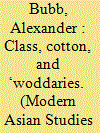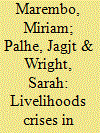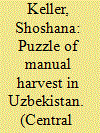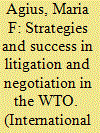|
|
|
Sort Order |
|
|
|
Items / Page
|
|
|
|
|
|
|
| Srl | Item |
| 1 |
ID:
155918


|
|
|
|
|
| Summary/Abstract |
This article makes use of a recently unearthed archive in Sweden, complemented by research in the India Office Records and Maharashtra State Archives, to explore the business networks of the small-scale railway contractor in 1860s Bombay Presidency. The argument centres on the career of one individual, comparing him with several contemporaries. In contrast to their civilian colleagues, freebooting engineers have been a somewhat understudied group. Sometimes lacking formal technical training, and without an official position in colonial India, they were distrusted as profiteering, even corrupt, opportunists. This article will present them instead as a diverse professional class, incorporating Parsis alongside various European nationalities, who became specialists in local milieux, sourcing timber and stone at the lowest prices and retaining the loyalty of itinerant labourers. It will propose that the 1860s cotton boom in western India provided them with a short-lived window of opportunity in which to flourish, and to diversify into a variety of speculative enterprises including cotton trading, land reclamation, and explosives. The accidents and bridge collapses of the 1867 monsoon, and subsequent public outcry, will be identified as a watershed after which that window of opportunity begins to shut. The article's concluding section analyses the contractors’ relationship with their labour force and its intermediary representatives, and strategies for defusing strikes. Ultimately, small independent contractors were agents of modernity not formally affiliated with the imperial project, and forced to bargain with merchants and strikers without official backing. Theirs is a record of complex negotiations at the local level, carried out in the immediate post-Mutiny settlement.
|
|
|
|
|
|
|
|
|
|
|
|
|
|
|
|
| 2 |
ID:
169267


|
|
|
|
|
| Summary/Abstract |
This study investigates oasis expansion in the precolonial period and agricultural evolution in the colonial period using village-level statistics from the early twentieth century. This survey illustrates that the Kokand oasis in the Ferghana Valley initially appeared in the central part, where the Sart population settled by the seventeenth century. In the eighteenth and nineteenth centuries, the Uzbek and Karakalpak tribes migrated to the valley peripheries, while the Kyrgyz semi-nomads settled in the alluvial fan. It is not surprising that such a migratory process created a mosaic-like ethnic distribution. Furthermore, this study suggests that the pattern coincided with a variety of agricultural practices, and presents two contrasting models of cotton monoculture under the Russian Empire. The main area occupied by the Sarts presents a general model of canal-irrigated cotton planting in Central Asia, while the Karakalpaks’ cotton planting using groundwater in the periphery suggests multiple courses of nomad sedentarization.
|
|
|
|
|
|
|
|
|
|
|
|
|
|
|
|
| 3 |
ID:
154558


|
|
|
|
|
| Summary/Abstract |
The Vidarbha region in Maharashtra, India, home to 3.4 million smallholder farmers, is a major cotton-producing region in one of the wealthiest Indian states. However, between 1995 and 2013, more than 60,000 farmers took their own lives. Many of these suicides have been linked to extreme debt created by the expensive mono-cropping of Bt cotton. Some farming households have responded to these pressures by abandoning Bt cotton growing and turning to sustainable agriculture using traditional mixed-cropping methods. Yet the question remains: have the changes produced better livelihoods in Vidarbha? Using a food sovereignty framework, we assess the impact of these changes through an analysis of a 200-household survey across six districts in Vidarbha. We also explore the meaning of food sovereignty for those who practise it, seeking to better understand some of the complexities and experiences associated with the term.
|
|
|
|
|
|
|
|
|
|
|
|
|
|
|
|
| 4 |
ID:
140447


|
|
|
|
|
| Summary/Abstract |
Uzbekistan has attracted international criticism for its use of child labour, defined as labour performed by youth under the Soviet legal limit of 16, to harvest cotton by hand. This article argues that manual labour, mostly performed by low-status children and women, became entrenched in Central Asian agriculture during the 1950s, and investigates the possible reasons for its persistence in the face of global trends to the contrary. The timing is a puzzle, because the 1950s were when mechanization of agriculture became a global development goal. The USSR participated in the mechanization trend. To understand better the roots of rural labour patterns in the Khrushchev period, we must consider how economic incentives and disincentives, gender relations, demographics, and state policy worked together.
|
|
|
|
|
|
|
|
|
|
|
|
|
|
|
|
| 5 |
ID:
156102


|
|
|
|
|
| Summary/Abstract |
What would a ‘good’ industrial policy in the realm of cotton production look like? This article seeks to address this question through a focus on reforms to the cotton sector in Kazakhstan. In contrast with neighbouring Uzbekistan and Turkmenistan, administrators in Kazakhstan had widely freed the cotton sector from government control as early as 1998. Agricultural collectives had been replaced by small private farms, and commercial cotton processors and traders entered the sector. However, in 2007, regulation tightened again and forced ginneries to use a complex warehouse receipt system without making sure that it was accepted by stakeholders and without appropriate institutions for implementing it in place. Moreover, it imposed financing restrictions on ginneries, which were major loan and input providers to farmers. In the following years, private producers and investors turned away from cotton, and cotton area and output fell substantially. We position our analysis in the broader debate about the right approach to industrial policy and argue that the cotton sector performance after 2007 shows how ill-designed regulation and government interference can turn a promising economic sector towards decline.
|
|
|
|
|
|
|
|
|
|
|
|
|
|
|
|
| 6 |
ID:
113960


|
|
|
|
|
| Publication |
2012.
|
| Summary/Abstract |
This article analyzes linkages between litigation in the World Trade Organization (WTO) Dispute Settlement Body (DSB) and negotiation in multilateral trade rounds and develops a typology of links that can occur between the two processes. These include creating conditions where bargaining is informed by law, influencing the agenda-setting and creating momentum for negotiation on key issues, and affecting the status quo from which negotiations proceed by influencing interpretation of trade rules in the DSB. The purpose is to test whether poor and inexperienced states that are disadvantaged in negotiations can improve their bargaining power in negotiation rounds by pursuing legal proceedings, to see whether links can be exploited for strategy-making to promote the interests of these states, and to discuss how the WTO as an international organization benefits from their empowerment. The strategies suggested in this article could improve the commitment and active participation of relatively non-influential member states. This could be conducive to perceptions of the WTO as a legitimate organization and to a more constructive climate for effective negotiations.
|
|
|
|
|
|
|
|
|
|
|
|
|
|
|
|
|
|
|
|
|